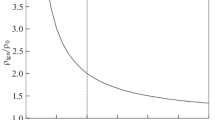Abstract.
The cellular detonation structure has been recorded for hybrid hydrogen/air/aluminium mixtures on 1.0 m \(\times\) 0.110 m soot plates. Addition of aluminium particles to the gaseous mixture changes its detonation velocity. For very fine particles and flakes, the detonation velocity is augmented and, in the same time, the cell width \(\lambda \) diminishes as compared with the characteristic cell size \(\lambda _0 \) of the mixture without particles. On the contrary, for large particles, the detonation velocity decreases and the cell size becomes larger than \(\lambda _0\). It appears that the correlation law between the cell size and the detonation velocity in the hybrid mixture is similar to the correlation between the cell size and the rate of detonation overdrive displayed for homogeneous gaseous mixtures. Moreover, this correlation law remains valid in hybrid mixtures for detonation velocities smaller than the value D\(_{\rm CJ}\) of the mixture without particles.
Similar content being viewed by others
Author information
Authors and Affiliations
Additional information
Received 10 May 2001 / Accepted 12 August 2002 Published online 19 December 2002
Correspondence to: B. Veyssiere (e-mail: veyssiere@lcd.ensma.fr)
Rights and permissions
About this article
Cite this article
Veyssiere, B., Ingignoli, W. Existence of the detonation cellular structure in two-phase hybrid mixtures. Shock Waves 12, 291–299 (2003). https://doi.org/10.1007/s00193-002-0168-8
Issue Date:
DOI: https://doi.org/10.1007/s00193-002-0168-8



